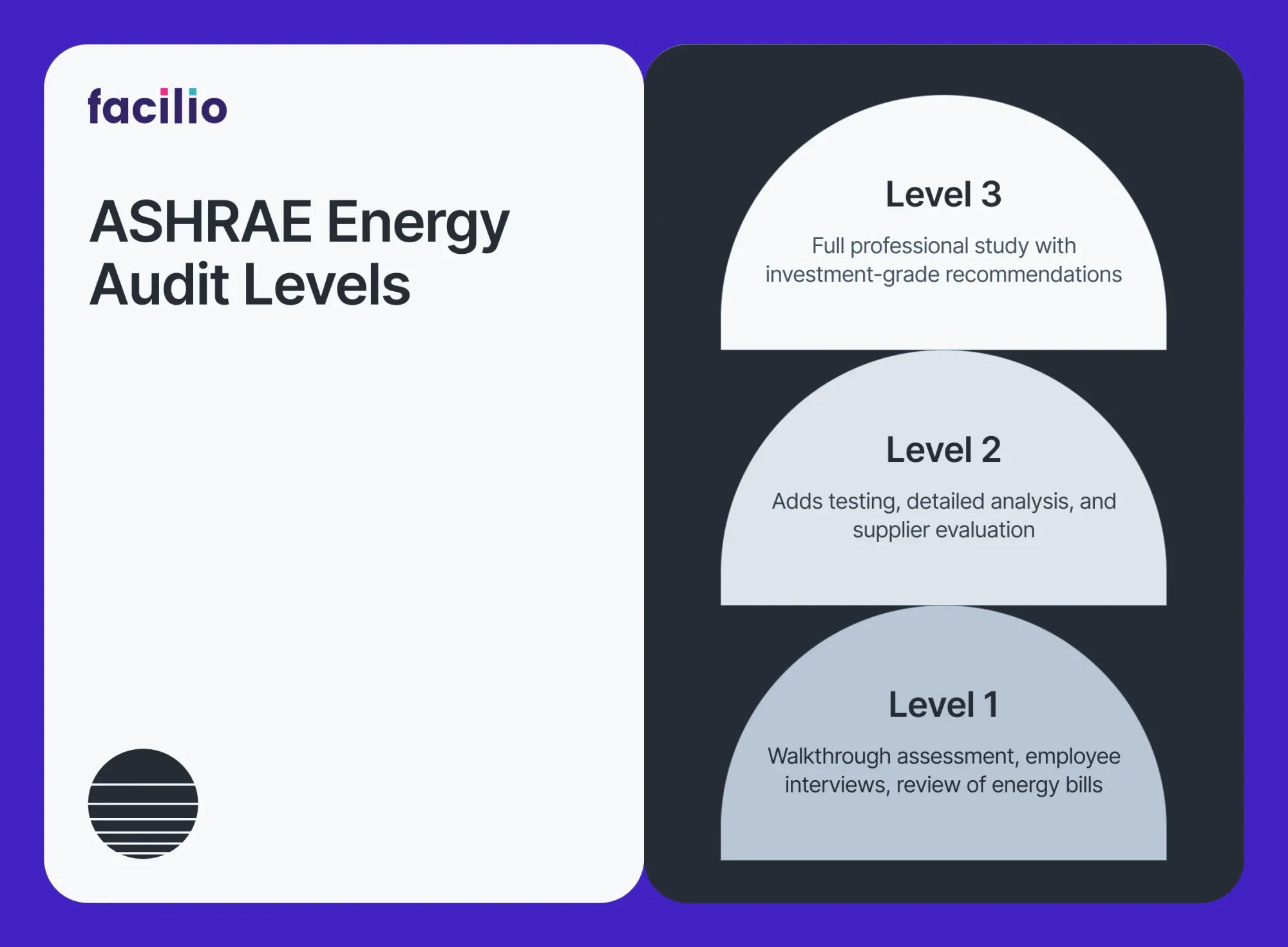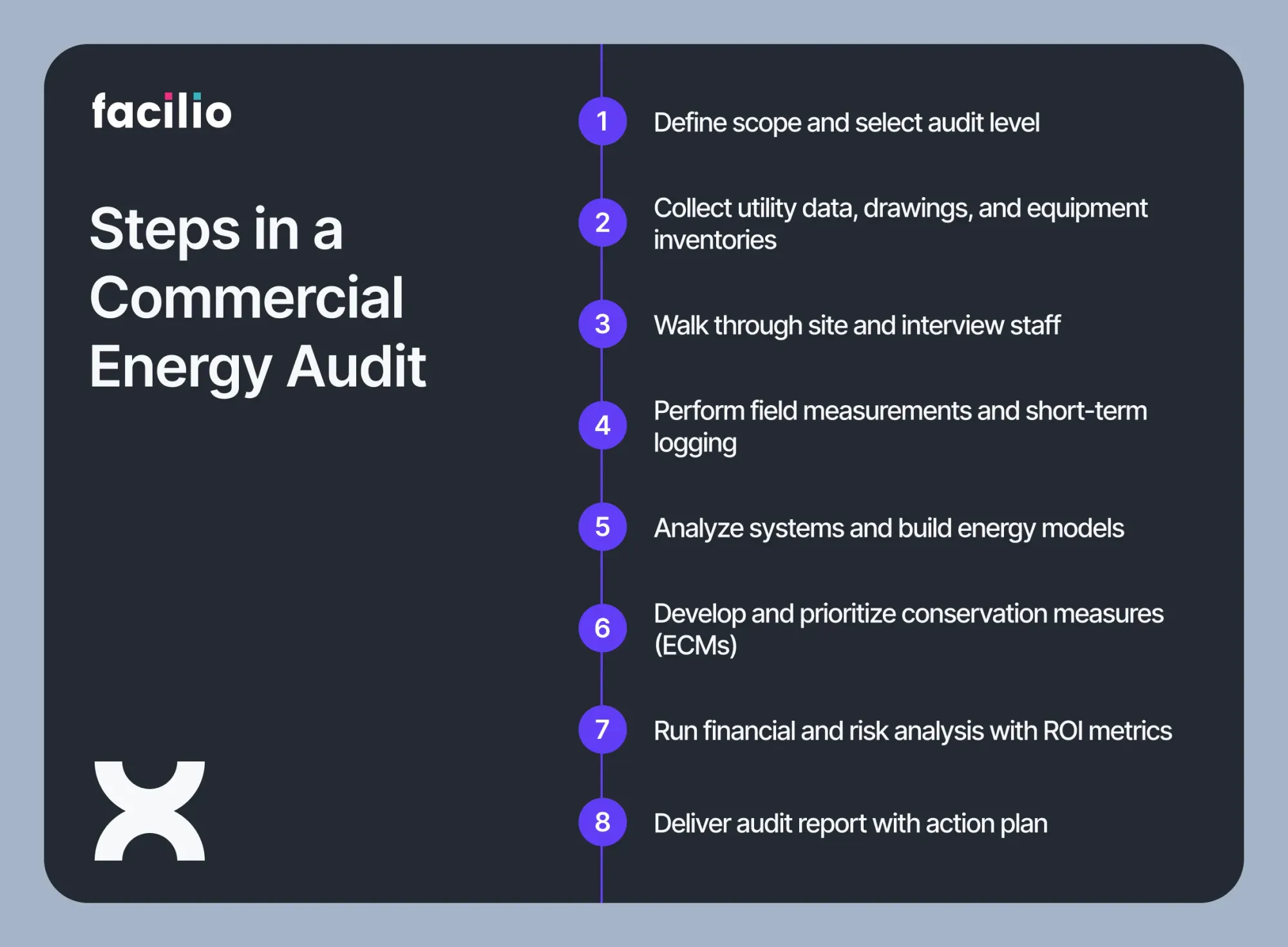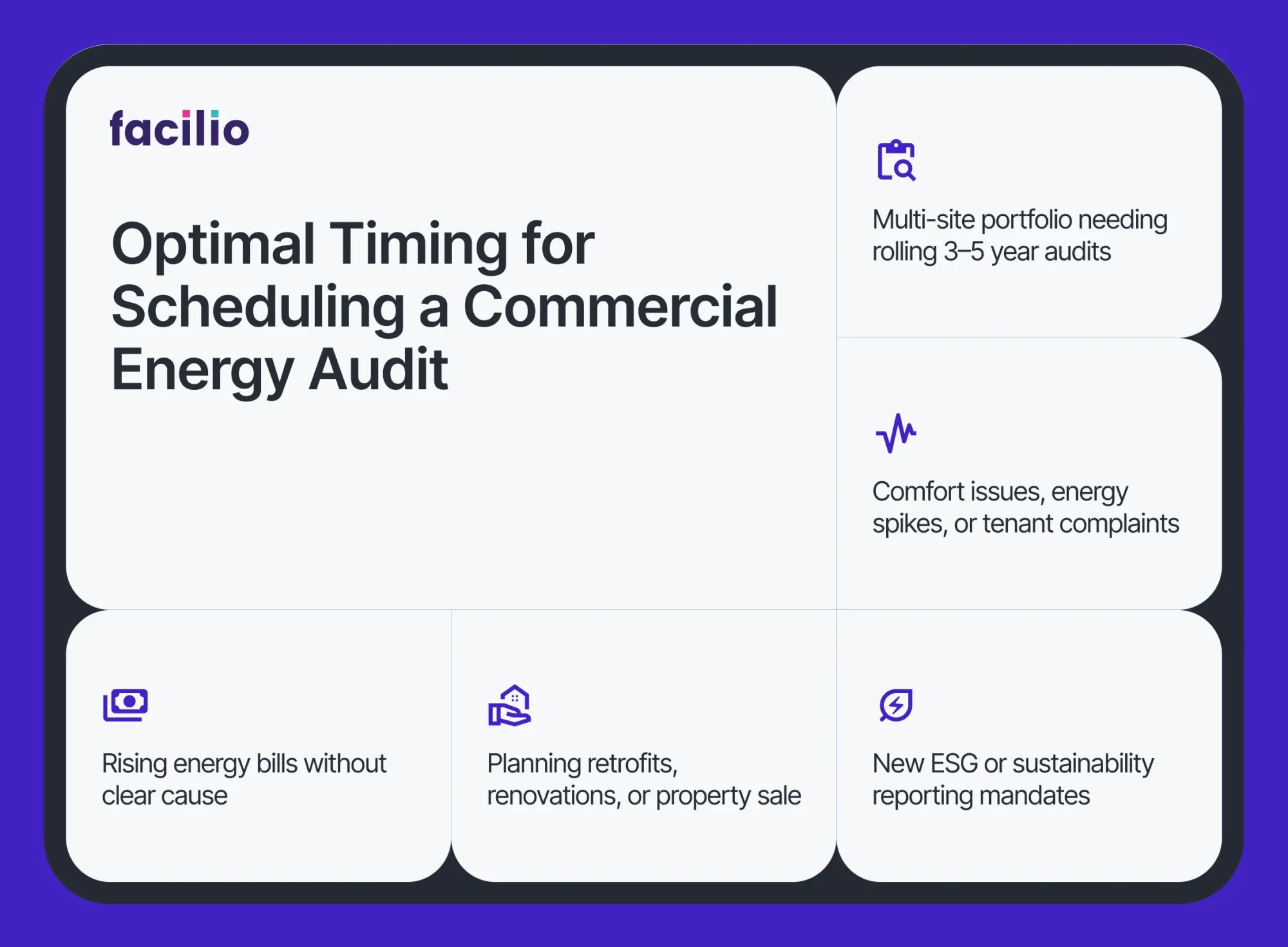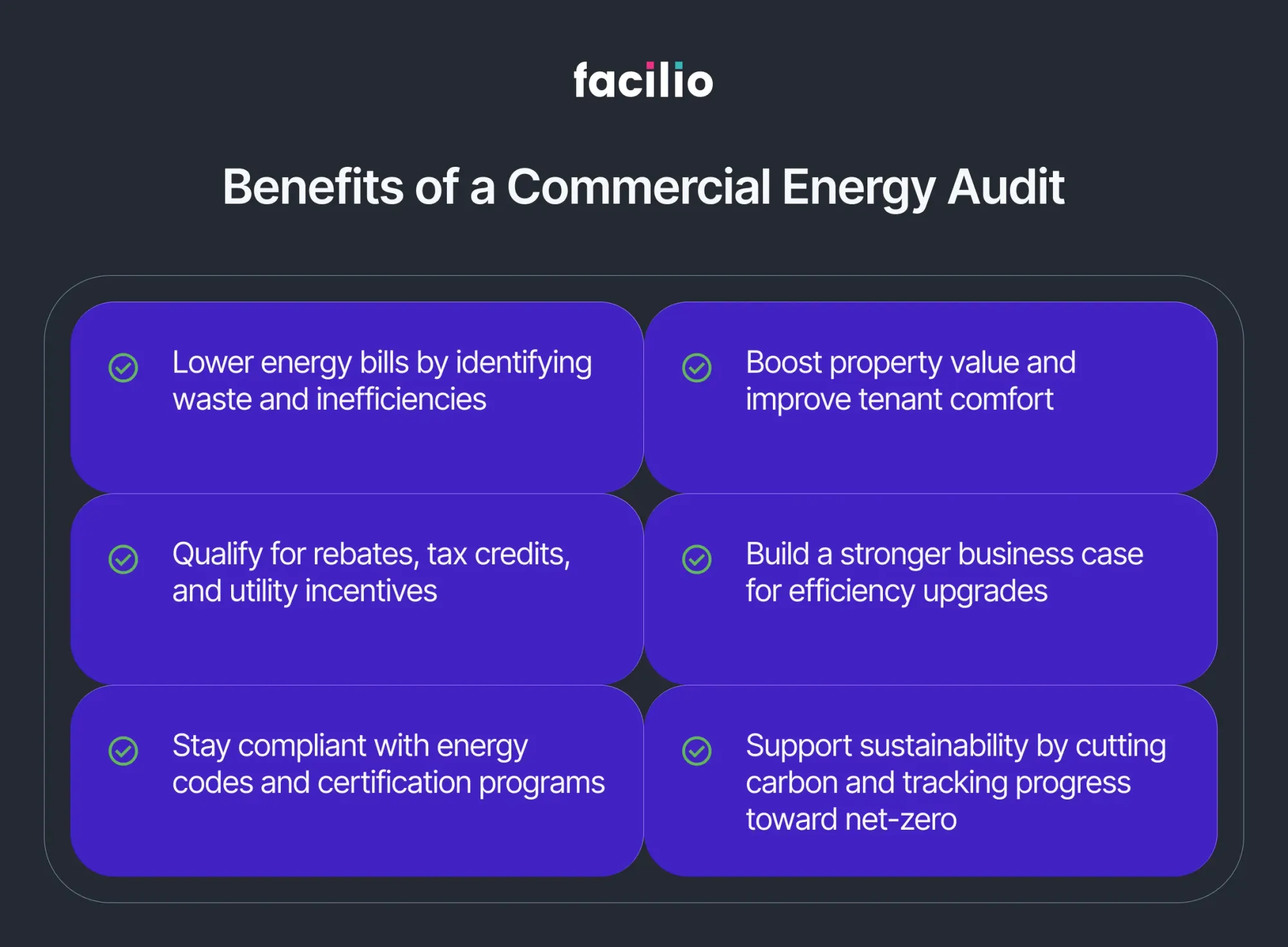How to Conduct a Commercial Energy Audit?
A commercial energy audit is performed to understand energy usage patterns in commercial buildings to reduce an organization's carbon footprint, ensure compliance, and promote an overall healthy environment.
This article covers the types of commercial energy audits, their benefits, factors to consider for an audit, and the steps required for success.
What is a commercial energy audit?
A commercial energy audit is a detailed analysis of a commercial building's energy usage patterns to identify areas of energy waste or excess usage and suggest upgrades to improve energy efficiency and minimize operating costs.
What are the three levels of energy audits defined by ASHRAE?

The American Society of Heating, Refrigerating, and Air-Conditioning Engineers (ASHRAE) defines three recognized levels of commercial energy audits.
These ASHRAE energy audit levels provide a framework for facilities to choose the right depth—whether a quick ASHRAE Level 1 audit, a more detailed Level 2, or an investment-grade Level 3.
ASHRAE Level 1: Walk-Through Analysis
A walk-through analysis is the most basic level of an energy audit. It gives small businesses or first-time clients a fast overview of energy use. For example, a small business energy audit at Level 1 may reveal outdated lighting or inefficient HVAC scheduling and recommend low-cost upgrades.
At this stage, an auditor will conduct a basic analysis of the energy consumption practices of the building and will then recommend energy-saving alternatives.
This analysis is conducted to:
- Form a foundation of level 2 and 3 audits
- Benchmark the most energy-efficient building to compare the rest against
- Discover the easiest ways to reduce energy wastage and optimize consumption
For example, a walk-through energy audit can identify that lighting fixtures in a building are outdated and inefficient. It’ll recommend replacing these with more energy-efficient solutions.
ASHRAE Level 2: Energy Survey Analysis
This audit breaks down energy consumption by major equipment, analyzing the cost efficiency of proposed measures and calculating a simple payback period.
ASHRAE Level 2 audit consists of a structured commercial energy analysis, looking at utility bills, load profiles, and equipment efficiency.
This type of assessment bridges the gap between operations and finance, showing which measures have short payback and which form part of longer-term commercial energy conservation initiatives.
For example, ASHRAE level 2 audit may identify that the HVAC system in a building is not working efficiently and recommend upgrading to a more energy-efficient system.
ASHRAE Level 3: Detailed Analysis of Capital-intensive Modifications
ASHRAE Level 3 energy audit uses sensors to collect granular data through computer-based simulations. It aims to supplement decision-making for capital-intensive projects identified in level 2.
The audit considers the life-cycle cost analysis of major equipment pieces, providing a high confidence margin for major capital allocation decisions. It’s the costliest of the three audits.
At this stage, a building auditor or consultant uses simulation tools, often supported by energy auditing software, to capture data and model financial outcomes.
For example, this audit may identify a building's insulation is insufficient and recommend a detailed insulation retrofit project, including costs, energy savings, and payback period.
Steps to conduct a successful commercial energy audit

Here’s a 10-step framework for conducting a commercial energy audit effectively. This process is widely recognized in ASHRAE energy audit levels and ensures that findings can evolve into actionable commercial energy conservation initiatives:
Step 1: Source relevant data and documents
Collect all your energy bills from the last 1-3 years. You should also gather other crucial property-related documents like the building plans, equipment manuals, maintenance history, occupancy data, and utility consumption rate information.
Step 2: Conduct a pre-audit assessment
The next step is a pre-audit assessment that reviews:
- Current energy use
- Occupancy patterns
- Maintenance records
- Building’s operating schedules
- Occupant interviews and surveys
- Equipment-wise energy consumption
This assessment sets the groundwork for your audit by compiling all the essential information in a single place.
Step 3: Perform a walk-through analysis
A walk-through analysis is a visual inspection of your facility's internal and external systems. This typically includes lighting, HVAC systems, insulation, windows, doors, and other energy systems.
The goal is to prepare a preliminary understanding of the scope for improvement and opportunities to optimize usage.
Step 4: Analyze energy usage
Once you’ve done the above legwork, use an energy management and optimization software to collect data about your current energy usage.
While a walk-through analysis offers a surface-level understanding of your building’s energy usage patterns, data analytics dig deeper to provide more actionable insights.
Step 5: Identify energy-saving measures
Combine your research from the above two steps to identify the scope for reducing consumption.
This involves strategically discussing the data and walk-through analysis reports to highlight the best energy-saving measures.
Step 6: Evaluate your assessment and its implication
Evaluate the estimated costs associated with implementing your energy-saving measures.
You can calculate the return on investment for each task to get a fair idea of the capital investment and subsequent savings.
Step 7: List and prioritize your recommendations
Rank your energy conservation measures in an order of priority—based on cost-effectiveness and expected ROI.
This prioritization will give the team a clear direction on what measures need immediate attention and which ones can be tabled for later.
Step 8: Develop a plan
Create a well-detailed plan including the recommended measures, implementation process, costs, and timelines.
Compile all findings and recommendations in a detailed and actionable document.
Step 9: Implement changes and monitor progress
Implement all the measures outlined in the report. Plan how to track and measure the efficiency of your strategies and review progress at least once every six months.
Step 10: Review and revise
Review the new progress report and compare whether the building’s energy consumption has become more efficient and cost-effective.
Identify gaps, if any, and take corrective measures to improve energy efficiency further.
How long does a commercial energy audit take?

The time it takes to complete commercial energy audits ranges from a few hours and weeks, depending on factors like:
- The size of your building or facility,
- The service you choose to conduct the audit,
- The level of detail you require for the report,
- Overall energy consumption and complexity of the unit
- Ease of accessibility to your building and energy systems
A small electricity audit for a single site may only take a day, while portfolio-wide facility energy performance audits involving detailed utility benchmarking can extend over multiple weeks.
Manual approaches rely heavily on visual inspections and physical measurements, making them resource-intensive and can take multiple weeks.
Cloud supervisory platforms like Facilio centralize energy consumption data across sites and establish internal and external baselines to help paint an accurate picture of portfolio-level energy efficiency, identify high-impact opportunities for optimization, and automate compliance.
7 factors affecting energy consumption in commercial buildings
Your building’s energy consumption patterns depend on multiple variables—from construction quality to occupancy. A well-designed energy efficiency audit process considers all these influences to deliver actionable recommendations:
Let’s look at the seven most critical factors impacting your energy consumption:
-
Building design and construction, like the orientation, window size and placement, insulation, and overall building design, can impact heating, cooling, and lighting.
-
HVAC systems are among the largest energy consumers in commercial buildings. The equipment's type, age, size, and efficiency impact its energy efficiency.
-
Current and long-term climatic conditions greatly impact energy consumption. For instance, there may be a higher demand for heating during winter, but the overall demand for cooling far outweighs all other factors due to rising global warming.
-
Lighting systems such as the type, fixtures, and daylighting use significantly impact commercial building energy consumption.
-
Different building types have varied electrical or thermal energy needs. For example, laboratories consume more energy than offices, classrooms, and community spaces.
-
Number of occupants determines how much energy will be required to heat, cool, and light the space.
-
Age of the building is a contributing factor, as older buildings may have outdated HVAC systems, insufficient insulation, and inefficient lighting systems.
-
Hours of operation influence energy use because longer operating hours lead to higher energy consumption. Some commercial buildings, such as data centers, operate 24/7, which can result in higher electrical energy consumption.
A feature-packed energy management software like Facilio gives you granular insights into all these factors with colored heatmaps and powerful data analytics. This helps assess your energy consumption across sites remotely and in real time.
5 benefits of a commercial energy audit

According to the U.S. Environmental Protection Agency, about 30% of commercial building energy is wasted for many reasons, like faulty electrical wires, incandescent light fixtures, refrigerant leaks, and more.
A well-executed facility energy performance audit or facility energy efficiency audit addresses this waste and sets the foundation for ongoing savings. Here are five core benefits of conducting energy audits in commercial buildings:
Increased utility consumption knowledge
A commercial energy audit helps understand the drift percentage from initial set points for every piece of equipment to help you recommission and optimize energy usage.
By combining energy audits & utility analysis, building operators gain deeper visibility into when and where inefficiencies occur. This makes it easier to recalibrate equipment, spot abnormal loads, and decide whether a targeted electricity audit is needed.
For example, identifying and fixing leaks in your HVAC system can help you save up to 30% on heating and cooling costs.
The audit also reviews crucial documents like energy bills and previous reports to identify consumption patterns and make data-informed decisions.
Improved regulatory compliance
Auditing your energy use shows how well your property complies with energy regulations or performance standards. This can save you from the hefty fines issued when violating these laws.
Failing to comply with the UK Energy Savings Opportunity Scheme (ESOS) can lead to an initial penalty of up to £5,000.
The path towards Net Zero
By pinpointing the inefficiencies in your current energy usage, a commercial energy audit indicates energy upgrades and investments to prepare a strategic roadmap toward renewable energy.
For example, the audit report can recommend improving the efficiency of HVAC systems, optimizing refrigeration systems, deploying a better leak detection mechanism, and more.
It can also suggest more capital-intensive measures, such as investing in a solar panel system to generate enough energy to offset the building's remaining energy consumption. This will enable your business to achieve net-zero status in the long run.
Further, it is vendor-agnostic, which means you can remotely command and control systems across multiple locations and deploy energy-saving strategies at scale to realize compounded savings in only weeks–not years!
Reduced energy consumption
An energy audit report can help businesses minimize consumption without compromising their productivity.
For example, the report might recommend improvements for the refrigeration system, like upgrading to high-efficiency compressors, insulating refrigeration pipes, and installing variable speed drives to control the speed of pumps to reduce energy consumption.
Increased property value
According to the International Energy Agency, businesses are ready to pay higher for green office buildings or buildings that are energy efficient.
This means upgrading your property's energy systems can increase its asset value in the market. Moreover, a highly energy-efficient building has a higher resale value because it has a more sustainable infrastructure.
Not just that, reporting on your ESG and net zero goals offers a lens into your organization’s energy maturity. This improves your brand positioning and enhances options for fundraising. Moreover, a strong ESG report directly impacts stock values.
The case for energy management platforms
and how they help achieve enterprise-wide energy efficiency
Most traditional energy conservation strategies like retrofitting are capital, time, and work intensive and may take several months or even years to show value–especially for large portfolios.
Taking a holistic approach to decarbonization with an energy management platform to inform your energy strategies with data-backed insights helps measure and verify potential savings from energy optimization strategies.
Identifying and capitalizing on these opportunities with a cloud-based software approach means O&M teams would have the flexibility and scale to lower operating costs across portfolios with centralized optimization of energy strategies and improved resource productivity via simple integrations, irrespective of vendors.
Facilio’s connected buildings solution can put you on the path to decarbonization, irrespective of your current processes and energy maturity.

